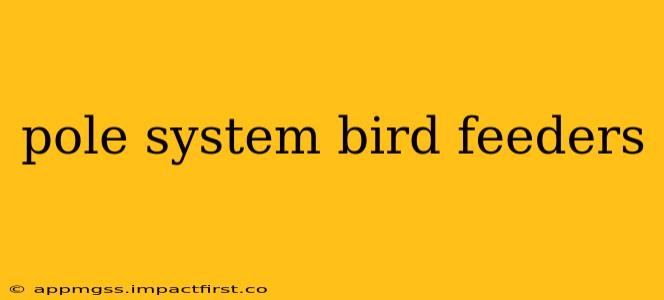Attract a vibrant array of feathered friends to your backyard with a pole system bird feeder! These feeders offer a practical and aesthetically pleasing way to provide food for birds while keeping it safe from squirrels and other unwanted guests. This guide dives deep into the world of pole system feeders, answering common questions and helping you choose the perfect one for your needs.
What are the benefits of using a pole system bird feeder?
Pole system bird feeders offer several key advantages over other feeder types. Firstly, the height provides a safe haven for birds, minimizing predation from ground-dwelling animals like cats and raccoons. Secondly, the distance from the ground and surrounding vegetation makes them less susceptible to contamination from droppings and other debris. Finally, a well-placed pole system feeder can be a beautiful addition to your landscape, adding a touch of nature to your backyard.
What are the different types of pole system bird feeders?
The market offers a wide variety of pole system bird feeders, each designed to cater to different bird species and preferences. Here are a few popular types:
- Tube Feeders: These are classic feeders with multiple feeding ports, ideal for smaller birds like finches and chickadees.
- Suet Feeders: Perfect for providing high-energy food during colder months, these feeders hold suet cakes or balls, a favorite among woodpeckers and nuthatches.
- Platform Feeders: These offer a large, open platform for various birds to feed simultaneously, but they are less squirrel-resistant compared to other designs.
- Hopper Feeders: These feeders dispense seeds from a hopper, often featuring protective baffles to deter squirrels. They can accommodate larger quantities of seed, reducing the need for frequent refills.
How do I choose the right pole for my bird feeder?
The pole is a crucial component of your pole system. Consider these factors when choosing one:
- Height: A taller pole generally provides better protection from predators and allows for better viewing. However, consider the height of your trees and other structures to ensure visibility and easy access for refilling.
- Material: Metal poles (aluminum or steel) are durable and weather-resistant. Wood poles offer a more natural aesthetic but require more maintenance.
- Sturdiness: Choose a pole that is strong enough to withstand wind and the weight of the feeder, especially when filled with seed.
How do I prevent squirrels from accessing my pole system bird feeder?
Squirrels are notorious for raiding bird feeders. Here's how to outsmart them:
- Squirrel-resistant feeders: Many feeders are designed with features like cages, baffles, or weight-activated closures that deter squirrels while allowing birds to access the food.
- Pole guards: These are cylindrical devices that prevent squirrels from climbing the pole to reach the feeder.
- Placement: Position the feeder away from trees or other structures that squirrels could use to jump onto the pole.
How high should I hang my pole bird feeder?
The ideal height depends on the specific birds you want to attract and the surrounding environment. Generally, a height of 5-8 feet is a good starting point. Hanging the feeder higher minimizes ground predator access, but it shouldn't be so high that it becomes difficult to fill and clean.
What kind of bird feeder is best for attracting specific bird species?
Different birds prefer different types of feeders and food. Researching the specific birds in your area will help you choose the appropriate feeder and seed to attract them. For instance, tube feeders are great for small birds, while platform feeders accommodate a wider variety. Suet feeders attract woodpeckers and nuthatches, while hopper feeders are versatile and can attract a range of species.
How often should I clean my pole system bird feeder?
Regular cleaning is crucial to prevent the spread of disease among birds. Clean your feeder at least once a month, or more frequently during warm, humid weather. Use a mild soap solution and rinse thoroughly before refilling.
By following these guidelines and selecting the right pole system bird feeder, you can create a thriving backyard ecosystem and enjoy the beauty of birds up close. Remember that observing and learning about the birds you attract adds to the overall enjoyment of this rewarding hobby.
